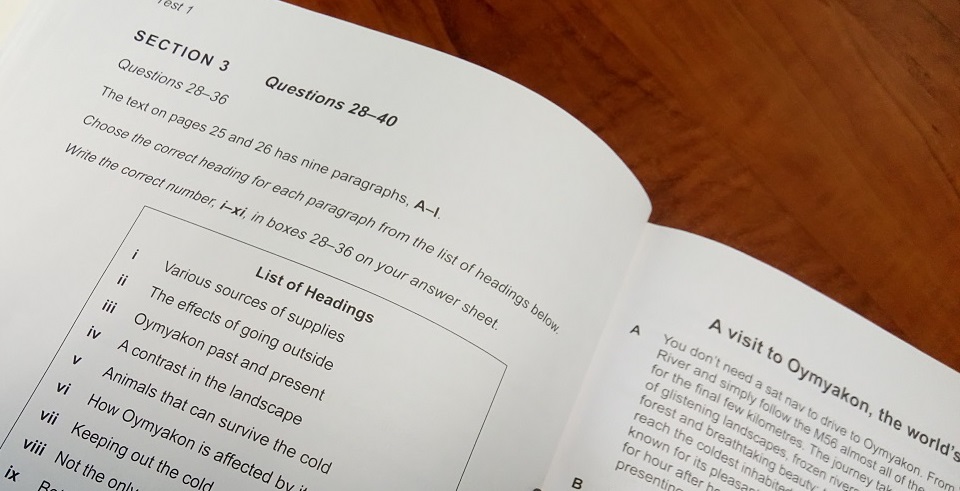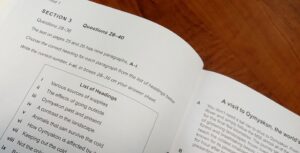IELTSジェネラルモジュールのリーディングは、全部でセクションが3つあり、問題数は40問です。
セクション3は、学術的な長文が出題され、難問と言われています。できるだけ時間をかけて取り組みましょう。
この記事では、セクション3の攻略方法を、例題と併せて紹介していきます。
セクション3の概要
IELTSジェネラルモジュールのリーディング試験は、次の3つのセクションで構成されています。
| リーディング(40問60分) | ジェネラル・モジュール |
|---|---|
| セクション1 | 短文が2つ出題される 広告や宣伝に関する文書 各文6~7問で、計12~14問 |
| セクション2 | 短文が2つ出題される 職場関連のルールや手順 各文6~7問で、計12~14問 |
| セクション3 | 2ページに渡る長文 学術的な内容 設問は約12~13問 |
最も難易度の高いセクション3
IELTSジェネラルのリーディングでは、セクション3が最も難しく、IELTSアカデミックと同じ難易度です。
セクション1とセクション2が解けても、セクション3で時間が足りなくなる人も少なくありません。
アカデミックな内容なので、本文を読むのに苦戦してしまうと、解答に割く時間が少なくなってしまいます。
バンドスコアと正答数
IELTSジェネラルでは、正答数ごとに、次のようにバンドスコアが設定されています。
| Band スコア | 9.0 | 8.5 | 8.0 | 7.5 | 7.0 | 6.5 | 6.0 | 5.5 | 5.0 | 4.5 | 4.0 | 3.5 |
| Score | 40 | 39 | 37-38 | 36 | 34-35 | 32-33 | 30-31 | 27-29 | 23-26 | 19-22 | 15-18 | 12-14 |
各セクションの設問数は12~13問、合計40問と設定されています。
他のセクションで全問正解でも、セクション3で1問も正解できないと、バンドスコアは5.5になってしまいます。
リーディングでバンドスコア6.0以上を目指す方は、必ずセクション3の対策を行いましょう。
解答のポイント
セクション3では、次のポイントを意識するかどうかで、点数が大きく開きます。
- いかに早く解くか
- 捨てるべき問題を見定め、潔く諦められるか
セクション3では、穴埋め問題など、確実に答えられる設問だけに集中し、点数を稼いでいきましょう。
解ける問題を確実に解くことが、高スコア獲得の近道です。
セクション1、セクション2の対策については、以下の記事で詳しく紹介していますので参考にしてください。


ジェネラルセクション3 問題形式別の対策
セクション3の出題形式は、次の4パターンです。
- タイトルマッチング問題(ヘッディング問題)
- 空欄穴埋め問題
- 選択問題
- True / False / Not given 問題
段落ごとのタイトルマッチング問題は、特に出題頻度が高く、ほとんどの場合で出題されます。
どの問題に取り組む場合でも、次の要素には印をつけ、振り返られるようにしておきましょう。
- 時間の流れ(年代など)
- 人の名前
※コンピュータテストでは、右クリックでハイライトを入れることができます。
例題
ここでは、同じ例題に対して、問題形式が変わると出題がどのように変わるのかを紹介していきます。
The Zebras’ long walk across Africa
James Gifford investigates some interesting new research into migration patterns of zebras living
in Botswana in southern Africa
A.
For any animal to travel over 270 km in Botswana partly across the sand and low bush terrain of the Kalahari Dessert is a remarkable achievement. But to do so in 11 days and without any obvious motivation, as this zebra population does, is quite extraordinary. On average their journey involves an exhausting round trip of 588 km – between the Makgadikgadi salt pan area and the Okavango river – making it second only to the great trek undertaken by the zebra herds in the Serengeti National Park. However, what is even more incredible still in my view is that until recently it was completely unheard of.
B.
Hattie Bartlam, a researcher, discovered this migration while she was tracking zebra groups, officially known as harems, by the Okavango River for her PhD, Each harem consists of a stallion and his seven or eight mares with juvenile foals. There is no loyalty between zebras beyond this social group, though harems often gather together into so-called herds. For her study, Hattie had planned to compare the small-scale movement patterns of 11 different zebra herds in the area.
C.
In December, when the annual rains had transformed the roads into rivers, Hattie was, therefore, more than a little surprised when she checked the data sent by the radio collars she fits to the zebras she is tracking to find that six of the harems were 270 km away on the edge of the Makgadikgadi, a huge mineral-rich area where salt has collected over the years as water evaporates in the heat. Then, when the last of the moisture from the rains had disappeared in May the following year, five of those harems came wearily back to the Okavango. This raised the question: why, despite a plentiful supply of food and water, were the zebras being drawn eastwards to the salt pans? Even more difficult to understand was what made six of the groups travel so far, while the other five remained by the Okavango.
D.
This discovery created quite a buzz in the research community. I decided to visit Hattie and she explained that a century ago the large number of Botswana’s zebra and wildebeest herds and the resulting competition for grass made migration essential. One of the migration tracks went from the Okavango to Makgadikgadi. But in the late 1960s, giant fences were put up to stop foot and mouth and other diseases spreading between wildlife and domestic cattle. One of these went across the migration track. Though the animals could get round the obstacle, each leg of their journey would now be 200 km longer – an impossible distance given the lack of permanent water on the extended route. Even today, with the fence gone (it was taken down in 2004), there is dangerously little drinking water to support the zebras on the return journey to the Okavango.
E.
As a zebra can live up to 20 years, the migration must have skipped at least one generation during the 40 or so years that the fences were up. This prompts another question: it has always been assumed that the young of social herbivores like zebras learn migratory behaviour from their parents, so how did the latest generation learn when and where to go? Not from their parents, who were prevented from migrating. Did they follow another species, such as elephants? We may never know.
F.
Hattie’s data points to the conclusion that there are several zebra populations adopting different behaviour. The first, like the vast majority of the Okavango zebras, take it easy, spending the entire year by the river. The second group, 15,000-20,000 strong, work a bit harder. They divide their time between the Makgadikgadi salt pans and the Boteti River, which is reasonably nearby. They sometimes struggle to find water in the Boteti area during the dry season, often moving 30 km in search of fresh grazing. Their reward: the juicy grass around the Makgadikgadi after the rains. The final group of zebras, whose numbers are more modest (though as yet unknown), must surely be considered as among the animal kingdom’s most remarkable athletes. By moving between the Okavango and the salt pans, they enjoy the best of both worlds. But the price they pay is an extraordinary journey across Botswana.
G.
Endangered species naturally tend to grab the headlines, so it’s refreshing for a relatively abundant animal like the zebra to be the centre of attention for once. Zebras are a vital part of the food chain: understanding their migration, in turn, helps us to interpret the movements of their predators, and Hattie’s research has shed light on the impact of fences on migratory animals. So what triggered her interest in zebras? She explains that it is easier to get funding to study exciting animals like lions. Crucial as that undoubtedly is, she believes that herbivores like zebras are key to understanding any ecosystem. The scientific community is fortunate that people like Hattie are willing to take the hard option
タイトルマッチング問題(ヘッディング問題)
タイトルマッチング問題は、本文の各段落と設問の見出しの内容を比べ、一致するものを選択する形式です。
しかし、段落をひとつひとつ丁寧に読んでしまうと、時間が足りなくなります。
英文の段落の構成を理解し、素早く、効率よく内容を理解できるように対策しましょう。
解答の手順
まずは本文のタイトルを読み、大まかな内容を把握しましょう。
段落を順に読み進めていきましょう。
全文を読まなくても解けるため、速読が苦手な方はすべてに目を通すことを潔く諦めましょう。
英文では、段落の冒頭にトピックセンテンスを書くのが一般的で、それによって段落の主題が明確になります。
1~2文目を確認し、それでも内容がわからない場合は、3文目も読むようにしましょう。
段落の冒頭にある2文は、必ず読むようにしましょう。
1文目が長く、すべての情報が詰まっているばあは、2文を読まなくても内容がわかる場合もあります。
最後の1~2文を読むことは非常に大切で、どのように段落が発展し、最後に至ったかがわかります。
最後の文だけで理解できなかった場合には、さらに3~4文先に戻って内容を確認しましょう。
解答のコツ
設問を解く際には、消去法を活用することがおすすめです。
ヘッディング問題では、まずAの段落を読み、次に設問の i から x までを読んで、当てはまるものを選びます。
途中で正解と思える選択肢があっても、最後まで設問を読むことを忘れないように気を付けましょう。
ヘッディング問題では、同じ選択肢を使うことは絶対にありません。
1問のミスが残りの問題に影響を与えてしまうので、確実と思える選択肢があっても、読み進めましょう。
確実でない選択肢は「これかな?」と目印を付け、より確実な選択肢があれば先に当てはめます。
選択肢をどんどん消去していき、選ぶ選択肢を少なくすることで自然と正解率が上がります。
例題
Questions 28-34
The reading passage has seven sections, A-G.
Choose the correct heading for each section from the list of headings below.
Write the correct number i-x, in boxes 28-34 on your answer sheet.
List of Headings
i. A decrease in the zebra population
ii. An obstruction on the traditional route
iii. An unknown species
iv. Some confusing information
v. Staying permanently in the Makgadikgadi
vi. Nearly a record in the zebra world
vii. Three different ways of living
viii. The original aim of the work
ix. How was the information passed on?
x. Why it is important to study zebras
※ここではA~Cの段落のみ解説していきます。
解答
段落A
vi. Nearly a record in the zebra world
段落B
viii. The original aim of the work
段落C
iv. Some confusing information
解説
段落A
まずは、段落の必要な部分だけを読み取り、内容を把握しましょう。
For any animal to travel over 270km in Botswana partly across the sand and low bush terrain of the Kalahari Desert is a remarkable achievement. (But to do so in 11 days and without any obvious motivation, as this zebra population does, is quite extraordinary.)
…………………………………………………………………………………
However, what is even more incredible still in my view is that until recently it was completely unheard of. However, what is even more incredible still in my view is that until recently it was completely unheard of.
どんな動物でも、カラハリ砂漠を超える270キロの旅は顕著な功績だ。(このシマウマが11日以内で、これと言った目的もなくそれをやってのけることは非常に並外れたことだ。)
…………………………
しかし、さらに私にとって信じられないことは、それが最近になるまで全然知られていなかったことだ
本文で”remarkable achievement”と”quite extraordinary”が使われており、「すごいことだ!!」を強調しています。
選択肢ⅵに使われている”record”は、「記録破り」、「最高記録」などと訳しますので、これが正解です。
単語の意味がわからない場合は、その都度覚えていきましょう。
段落B
Hattie Bartlam, a researcher, discovered this migration while she was tracking zebra groups, officially known as harems, by the Okavango river for her PhD. ( Each Harem consists of a stallion and his seven or eight mares with juvenile foals)
……………………………………………………………………………………………………………………………………..
For her study, Hattie had planned to compare the small-scale movement patterns of 11 different zebra herds in the area.
Hattie という研究者が PhD のために Okavango 側付近でゼブラのグループを追跡している時にこの移動を発見した。(それぞれのグループは1頭のオスと子供を引き連れた 7,8 頭のメスから構成されている)
…………………………
研究のために、Hattie はその付近の11の異なったゼブラの群れの小規模な移動パターンを比べることを計画した。
ここから言えることは、ⅷの”The original aim of the work”のひとつだけです。
段落C
In December, when the annual rains had transformed the roads into rivers, Hattie was, therefore, more than a little surprised when she checked the data sent by the radio collars she fits to the zebras she is tracking to find the six of the harems were 270km away of the edge of the Makgadikgadi, a huge mineral-rich area where salt has collected over the years as water evaporates in the heat.
………………………………………………………………………………………………………………………
Even more difficult to understand was what made six of the groups travel so far, while the other five remained by the Okavango.
ここでは、12月になると雨季になり道が川に変わる。そのためHattieは 研究中の発信機をつけたゼブラの群れをチェックした時、6つの群れが270キロ離れた所にいると分かって大変驚いた。(長文のため要約しています)
…………………………………………………………………………………………………….
さらにもっと理解に苦しむことは、5つの群れが近くにとどまっている中、6つの群れがなぜそんなに遠くまで移動したのかということだ。
消去法で上から順番に見ていくと、ここで言えることは、ⅳの”Some confusing information”です。
このことに彼女は驚き、理解に苦しんだのです。
トピックセンテンスや最後の2文を読んでも、段落の内容がわからないこともあります。
その場合は、その段落は最後に回してさっと読み、最後に残った選択肢を参照しながら解答しましょう。
空欄の穴埋め問題
穴埋め問題では、文章をの内容を補うように、空欄に適切な単語を埋めていきます。
解答のコツ
問題文からキーワードを見つけ、その内容が記載されている段落をじっくり精読して解いていきましょう。
内容が理解できなくても、言い換えや前後関係から推測して解答を導けるので、スコアを獲得したい問題です。
内容が2段落にまたがる問題や、離れた段落に答えがある問題では、潔く諦め、次の問題に進みましょう。
例題
Zebra tend to live together in small units, which experts call 1…………………….. Here, male zebra has charge of a number of adult 2…………………..and their young. These units sometimes assemble in bigger groupings or 3………………………, but it is still clear that the zebras’ loyalty only extends to the small unit they live in.
解答
1…………………
Harems
2…………………..
mares
3…………………..
herds
解説
まずは、「シマウマが小さな単位で暮らしていること」について書かれている段落を探しましょう。
この例題では、Bの段落で詳しく記述されているため、この段落をじっくり読み進めましょう。
選択問題
選択問題は、設問が用意されており、適切な選択肢を解答していく形式です。
解答のコツ
選択問題も穴埋め問題と同様に、設問のキーワードを見つけ、その内容について記述されている段落を精読します。
重要なことは、想像力を働かせず、ただ書かれているままの内容で正誤を判断していくことです。
例題
1 .How did Hattie feel when she heard some of the zebras had traveled so far?
A) Annoyed because she would have to follow them to Makgadikgadi
B) Disappointed that not all of them made it back to Okavango
C) Frustrated as the rains had made the roads unusable
D) Unsure as to their real motivation for going
2. When describing the different Botswana zebra populations, the writer indicated
A) His admiration for the ones who migrate the furthest distance.
B) His sympathy for the ones who stay by the Okavango River
C) His disbelief that those by the Boteti have difficulty finding food.
D) His anxiety that their migration patterns may not be able to continue.
解答
1 .How did Hattie feel when she heard some of the zebras had traveled so far?
D
2. When describing the different Botswana zebra populations, the writer indicated
A
解説
設問1
設問では、Hattieが感じたことを問われているため、彼女の感情表現が書いてあるCの段落を精読します。
設問の選択肢のキーワードは次の4つです。本文中から、このキーワードと同じ内容を探しましょう。
- “annoyed”:いらいらする
- “disappointed”:がっかりした
- “frustrated”:フラストレーションがたまる
- “unsure”:とまどう
本文で次の記述があることから、正解はDの”unsure”になります。
This raised the question……what made six of the groups travel so far?
設問2
この設問では、作者がボツワナのシマウマの群れの数について説明している段落であるEを精読します。
設問の選択肢のキーワードは次の4つです。本文中から、このキーワードと同じ内容を探しましょう。
- “admiration”:賞賛
- “sympathy”:同情
- “disbelief”:不信
- “anxiety”:不安
本文で次の記述があることから、正解はAの”admiration”になります。
The final group of zebras, whose numbers are more modest, must surely be considered as among animal kingdom’s most remarkable athletes.
True / False / Not given 問題
この形式は、IELTS特有の問題で、IELTSアカデミック、IELTSジェネラルの両方で頻繁に出題されます。
“False”と”Not Given”の違いなど、リーディング力だけでなく問題への理解も重要になる問題形式です。
次の記事で詳しい対策方法を紹介してますので、攻略の参考にしてください。


IELTS ジェネラルリーディング 【セクション3 対策】まとめ
IELTSジェネラルのリーディング試験において、セクション3は難易度が最も高いと言われています。
これは、学術的な長文が出題されるため、内容が難しく、時間が足りなくなることが多いためです。
本文をすべて読んでしまうと、時間が足りなくなってしまうので、段落のトピックセンテンスと最後の文章だけを読み、内容を想定して解いていきましょう。
セクション3では、確実に解答できる設問を優先して解いていきます。不確かで、時間がかかりそうな設問は潔く諦めましょう。捨てる問題と拾う問題に分けて、時間をうまく使い、正答率を高めましょう。
ただし、穴埋め問題は前後関係で解答を予測しやすいので、キーワードを見つけ段落を精読し、しっかりとスコアを獲得していきましょう。
無駄のない効果的な対策を!



